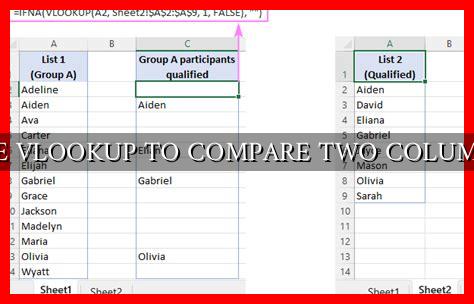-
Table of Contents
Using VLOOKUP to Compare Two Columns
When working with large datasets in Excel, it can be challenging to compare information across multiple columns. However, with the help of the VLOOKUP function, you can easily compare two columns and retrieve relevant data. In this article, we will explore how to use VLOOKUP to compare two columns effectively.
Understanding the VLOOKUP Function
The VLOOKUP function in Excel allows you to search for a value in the first column of a range and return a value in the same row from another column. This function is commonly used to perform lookups and comparisons in Excel spreadsheets.
Comparing Two Columns Using VLOOKUP
To compare two columns using VLOOKUP, follow these steps:
- Select the cell where you want the comparison result to appear.
- Enter the VLOOKUP formula:
=VLOOKUP(lookup_value, table_array, col_index_num, [range_lookup]) - Specify the lookup value as the cell in the first column you want to compare.
- Define the table array as the range containing the two columns you want to compare.
- Set the column index number to the column from which you want to retrieve data.
- Choose the range lookup option based on your comparison requirements.
- Press Enter to see the comparison result.
Example of Using VLOOKUP to Compare Two Columns
Let’s consider an example where we have two columns: Column A contains a list of employee IDs, and Column B contains their corresponding names. We want to compare the employee IDs in Column A with a separate list of IDs in Column D and retrieve the names of matching IDs from Column B.
In this scenario, we can use the following VLOOKUP formula:
=VLOOKUP(D2, A:B, 2, FALSE)
Here, D2 is the cell containing the employee ID we want to compare, A:B represents the range of columns A and B, 2 specifies that we want to retrieve data from the second column (names), and FALSE ensures an exact match.
Benefits of Using VLOOKUP for Column Comparison
Using VLOOKUP to compare two columns offers several benefits:
- Efficiency: VLOOKUP simplifies the process of comparing data in Excel, saving time and effort.
- Accuracy: The function helps avoid manual errors that may occur during manual comparisons.
- Scalability: VLOOKUP can handle large datasets efficiently, making it suitable for complex comparisons.
Conclusion
By leveraging the power of the VLOOKUP function in Excel, you can easily compare two columns and retrieve relevant data with precision.
. This tool is invaluable for data analysis, reporting, and decision-making tasks. Incorporating VLOOKUP into your workflow can streamline your processes and enhance the accuracy of your comparisons.
For more advanced techniques and tips on using VLOOKUP, consider exploring additional resources such as Microsoft’s official documentation.





